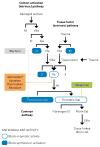Exploring indications for the Use of direct oral anticoagulants and the associated risks of major bleeding
- PMID: 28581331
- PMCID: PMC5568002
Exploring indications for the Use of direct oral anticoagulants and the associated risks of major bleeding
Abstract
Thrombosis is a leading cause of morbidity and mortality in the United States. Arterial and venous thromboses are implicated in the pathogenesis of major disorders, including myocardial infarction, ischemic stroke, and venous thromboembolism. Over the past decade, direct oral anticoagulants (DOACs) (eg, direct thrombin inhibitor and factor Xa [FXa] inhibitors) have been adopted as alternatives to warfarin due to their clinical advantages and efficacy for the treatment of thrombosis. As with all anticoagulants, treatment with DOACs is associated with a risk of major bleeding, including life-threatening gastrointestinal bleeds and intracranial hemorrhages (ICHs). In turn, the burden of bleeding associated with DOAC treatment is itself associated with substantial healthcare costs that are amplified by an increased risk of thromboembolic events and mortality following major bleeding events, especially in patients with ICHs. Given the rapid adoption of the DOACs and projected usage in the large patient population affected by thromboembolic conditions, clinicians are increasingly likely to encounter patients with major bleeding events due to DOAC therapy. Unlike warfarin, effective strategies to manage these bleeds are limited. There is an unmet need for reversal agents for use in the management of patients who receive FXa inhibitors and experience life-threatening bleeding or need emergency surgery. Andexanet alfa and ciraparantag are being evaluated as potential antidotes for both direct and indirect FXa inhibitors.
Figures




References
-
- Virchow RLK. Thrombose und Embolie. Gefässentzündung und septische Infektion. Gesammelte Abhandlungen zur wissenschaftli-chen Medicin. Frankfurt am Main: Von Meidinger & Sohn; 1856. pp. 219–732. Translation in Matzdorff AC, Bell WR. Thrombosis and Embolie (1846–1856). Canton, MA: Science History Publications; 1998. ISBN 0-88135-113-X.
MeSH terms
Substances
Grants and funding
LinkOut - more resources
Full Text Sources
Medical
Research Materials
Miscellaneous
